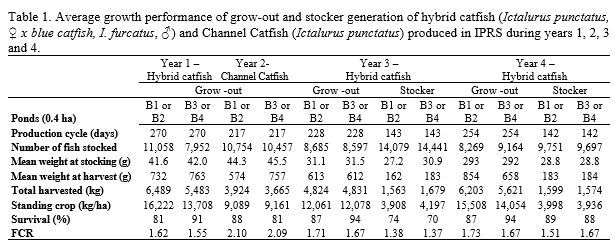IN-POND RACEWAY SYSTEM: PERFORMANCE AND PROFITABILITY
In-pond raceways systems (IPRS) can have higher fish yields than conventionally managed catfish ponds (8,000 kg/ha) with IPRS units having annual fish production greater than 15,000 kg/ha . A four-year project at Auburn University was initiated with the objective of evaluating the performance and economic efficiency of fish produced in IPRS units . For this four-year trial, a f loating IPRS unit was placed into each of four 0.4 ha ponds . In year 1, Ponds B1 and B2 had 64 m3 IPRS units place into them, and ponds B3 and B4 had 45 m3 units. Each pond had a total of 3 HP of aeration: a 1.5 HP blower for the IPRS unit, plus a 1.5 HP blower for the in-pond water mover-destratification unit. Hybrid catfish were grown during Year 1 using a large raceway ("grow-out") with 3.0 HP aerator and in year 2 Channel catfish were grown using 4.0 HP aerator. In Year 3 the previous year configuration was used and added a smaller raceway ("stocker generator") next to the grow-out raceways (also 2.0 HP was added in each pond). Once grow-out units were harvested, the stockers would be harvested and placed into the vacated, adjacent grow- out unit for growth to foodsize fish. For Year 4, a tilapia cage was placed into 2 of the 4 ponds (B2 and B4) and were used to reduce blue-green algae populations and large daily dissolved oxygen variations. Five HP of aeration was kept (maintaining the dissolved oxygen above 3 mg L-1). Fish were fed a 32% CP commercial diet twice daily. Water quality parameters had acceptable ranges for all years . Total production (all years) equaled or surpassed production yields from conventional catfish pond production systems. Growth performance r esults from years 1-4 are summarized in Table 1.
Hybrid catfish (from Year 1) performed better than Channel catfish (from Year 2). Hybrid catfish (stocker + grow-out) had yields ranging from 15,969 to 16,275 kg/ha (Year 3) . In Year 4, tilapia (2,175kg/ha) increased total production by 11%, with no additional feeding (total yields ranged from 17,990 to19,506 kg/ha. Enterprise budget fixed and variable costs were developed using actual investment and production data. Costs of production varied among raceways and were influenced by survival and FCR. Accounting enterprise budgets (net return calculated minus the value of non-cash inputs) are closer to what adopters of this technology would actually encounter and showed positive net returns for hybrid catfish in years 1, 3 and 4. Full four-year trial results and enterprise budgets will be presented at the Aquaculture America meeting.
